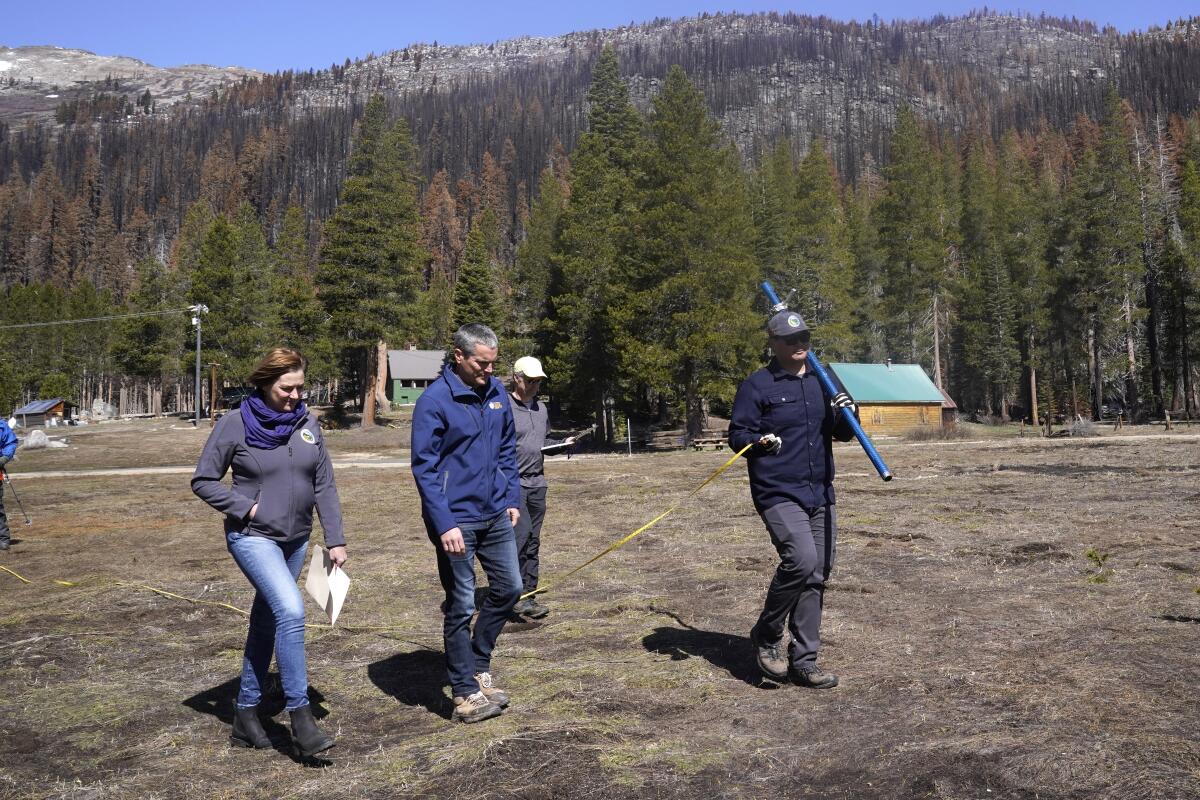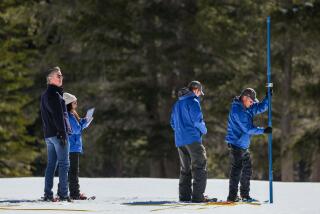Californians urged to save water as state faces dismal snowpack in Sierra Nevada

- Share via
California is going into spring with a minuscule amount of snow in the Sierra Nevada, leaving the state in a third year of extreme drought and with depleted reservoirs to draw on during what’s likely to be another hot, parched summer.
The mountain snowpack, as measured by snow sensors across the Sierras, now stands at just 38% of the long-term average.
State officials stood on bare ground at a snow survey site in the mountains on Friday, saying the paltry snowpack reflects the state’s accelerating water challenges with climate change.
“We are calling on all Californians to use water wisely, to conserve as much as you can,” said Karla Nemeth, director of the state Department of Water Resources.
Snow typically makes up nearly a third of California’s water supply and feeds reservoirs across Northern California as it melts in the spring and summer.
The levels of most of California’s biggest reservoirs, from Shasta Lake to San Luis Reservoir, measure far below average.
“Climate change is here and it’s changing our state. It’s changing our region,” said Wade Crowfoot, the state’s natural resources secretary.
Gov. Gavin Newsom this week issued an order for urban water suppliers to implement more aggressive conservation measures, requiring them to activate “Level 2” of their local drought contingency plans to prepare for shortages.
Water deliveries have also been cut back for many farming areas in the state this year. Nemeth said those cutbacks are expected to lead to more farmland being left dry and unplanted.
Warmer temperatures brought on by climate change have been making droughts more intense in California and across the West. Scientists have found that the extreme dryness since 2000 in the West, from Montana to northern Mexico, now ranks as the driest 22-year period in at least 1,200 years and has been worsened by the heating of the planet.
The past three years have been among California’s driest on record.
Last year, the Sierra Nevada snowpack peaked at 72% of average in April but then rapidly melted during the hottest spring on record.
California ended 2021 with major storms that blanketed the Sierra Nevada with above-average snow. But that bounty swiftly dwindled during the driest January through March on record.
State officials spoke at the Phillips Station snow survey site, where they’ve been measuring the snowpack since 1941. The snow at the site was 2½ inches deep, just 4% of average, said Sean de Guzman, water supply forecasting manager for the Department of Water Resources.
Crowfoot noted that seven years ago, during the last severe drought, Gov. Jerry Brown had stood at the same spot on bare, dry ground. Since then, Crowfoot said, five of the last seven winters have been dry. And warmer temperatures have meant that more of the snow and rain that falls is absorbed into dry soils or evaporates before the water can reach streams and reservoirs.
“The question is, what are we going to do about it?” he said. “We are not bystanders to the climate crisis. We are protagonists.”
He pointed out that the Colorado River, which supplies water to parts of California and six other states and Mexico, has also shrunk dramatically during two decades of dryness intensified by unprecedented warmth, and is facing “alarming water conditions” as its reservoirs continue to decline.
While working to reduce carbon pollution, Crowfoot said, the state needs to adjust to the warmer, drier climate.
“Communities across our state need to eliminate water waste, continue to become more efficient with the water that’s used,” Crowfoot said. Echoing an appeal made by Brown during the last drought, he said everyone needs to “make conservation a way of life.”
California’s water management officials use April 1 as a benchmark date for estimating how much water will come from snow because it’s traditionally when the snowpack reaches its peak. But this year, the snowpack in the northern Sierra Nevada peaked around mid-January and has been shrinking.
Reservoir levels statewide are now at less than half their full capacity, about 70% of the long-term average.
Nemeth said that in December, at the same site south of Lake Tahoe, the snow had been 6½ feet deep. On Friday, the surveyors measured the depth of a patch of snow in the dry meadow.
“What we see here today is actually very evocative of 2015, with growing evidence that suggests that perhaps this drought is actually a continuation of that very dry period we experienced several years ago,” Nemeth said. “You need no more evidence than standing here on this very dry landscape to understand some of the challenges we’re facing here in California, and all Californians need to do their part.”
She said the many ways people can conserve at home include watering less outdoors, watering at night or letting lawns go brown.
In July, Newsom called for Californians to voluntarily reduce water use 15%. But statewide water savings in cities and towns through the end of January stood at less than half that goal.
Crowfoot said state officials learned from the last drought that instead of a “a one-size-fits-all solution out of Sacramento,” communities need to take different steps based on their local circumstances. He said the Newsom administration is working with regulators at the State Water Resources Control Board, asking them to “consider requiring each urban water agency to trigger specific actions.”
“We are confident that these specific actions, combined with the work already underway to build awareness of water conservation, will help us navigate through the drought,” Crowfoot said.
Nemeth said she expects that in parts of the state, mandatory water restrictions could be in place by summertime.
Dialing down outdoor watering, which accounts for about half of urban water use, can make a big difference, Nemeth said. She urged residents to take advantage of rebates that local water agencies offer for removing grass or switching to more efficient appliances.
“We need to do more, and we can do more. And there are increasing ways to do that, I think, that are convenient,” Nemeth said.
Some researchers have said the state should adopt mandatory conservation measures and accelerate efforts toward improving water efficiency and invest in projects to recycle wastewater and capture runoff when rains come.
“The snowpack survey confirms the historic severity of the drought and is extremely concerning. It underscores that climate change is water change,” said Amanda Bielawski, director of communications for the Pacific Institute, a think tank in Oakland. She said the situation “should spur water decision makers to push for innovative solutions that put water resilience at the center.”
Among other things, Newsom’s latest drought order directs state regulators to consider a ban on watering “non-functional” grass at businesses and other properties. The order seeks to combat chronic overpumping of groundwater in farming areas, which has left hundreds of homes with dry wells, by prohibiting local governments from granting permits for any new well-drilling that would be “inconsistent” with management plans.
The governor’s order also streamlines permitting for groundwater recharge projects, where stormwater runoff can be captured and percolate into the soil to boost aquifers.
Under California’s landmark 2014 groundwater law, the Sustainable Groundwater Management Act, local agencies in areas where aquifer levels have been dropping are required to implement plans to address their overdraft problems by 2040. Those plans have yet to take effect, and many local agencies have yet to limit groundwater pumping.
The meager snowpack, earlier snowmelt and warm conditions this year are “clear features of the onset of climate change,” said Angel Fernandez-Bou, a water researcher at UC Merced. “With less surface water for irrigation, farmers may need to pump more groundwater, which is being pumped at an unsustainable rate.”
Looking to the future, Fernandez-Bou said, potential solutions include establishing sites to recharge aquifers when water is available in wet years, and preparing to shift some farmlands to other purposes, such as solar farms and wildlife habitat areas.
According to state data, agriculture accounts for nearly 80% of the water that is diverted and pumped for human use in an average year.
California can still have a strong agricultural economy in the future, but it will look different as the state adapts to a more extreme climate, Nemeth said. And the acreage of cultivated farmland is set to shrink, she said, “in response to this real need to better manage our groundwater.”
More to Read
Sign up for Essential California
The most important California stories and recommendations in your inbox every morning.
You may occasionally receive promotional content from the Los Angeles Times.










